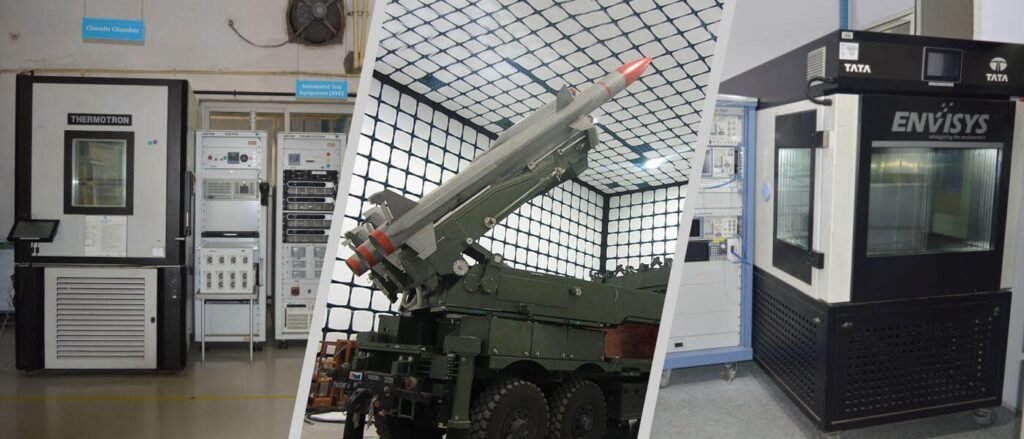Ensuring Legal and Quality Standards Electromagnetic Interference (EMI) and Electromagnetic Compatibility (EMC) are key in the making and designing of electronic devices. Making sure that electronic products pass EMI/EMC standards is crucial for legal reasons and device performance. eTAZ systems EMI/EMC testing services are essential in checking that electronic devices work properly without causing or being influenced by electromagnetic disruptions. In this post, we’ll dig into the importance of EMI/EMC testing, the test process, and answer common questions about these services.
Understanding EMI and EMC Electromagnetic Interference (EMI):

An electronic device causes unwanted disruption, known as EMI, which could interfere with the working of other devices. These disruptions could come from many places, like power lines, radio waves, or other electronics.
Electromagnetic Compatibility (EMC):
EMC is how well an electronic device can work in its electromagnetic environment without causing excessive disruptions to other devices. EMC ensures that EMI doesn’t hamper the device’s performance and that the device doesn’t emit EMI that could disrupt other devices. Why EMI/EMC Testing is Important Legal Requirements: Most countries or regions have strict rules for EMI/EMC to ensure electronic devices are safe and dependable. To legally sell the devices in these markets, they must pass
EMI/EMC tests. Device Performance:
Testing for EMI/EMC identifies possible problems that could impact the device’s performance. This means the device works reliably in the environment it was intended for.
Safety:
Making sure a device doesn’t emit too much EMI keeps users and other electronic devices safe from possible dangers.
Market Approval:
If a product sticks to EMI/EMC standards, it boosts the reputation of the product and the manufacturer, leading to wider acceptance in the market. The EMI/EMC Testing
Process Pre-compliance Testing:
Testing in the early stages to find and solve potential EMI/EMC Test Services issues during design. Emissions Testing: Measuring the electromagnetic emissions from the device to check they’re within safe limits.
Immunity Testing: Checking the device’s resistance to electromagnetic disruptions from outside. Both Radiated and Conducted Emissions: Testing both types of emissions (airborne and via cables) for compliance. Documentation and Reporting: Full documentation of the test process and results, crucial for legal submissions.
FAQs on EMI/EMC Testing
Q1: What’s the difference between EMI and EMC?
A1: EMI deals with unwanted electromagnetic disruptions produced by electronic devices. On the other hand, EMC looks at whether a device can perform efficiently in its electromagnetic surroundings without causing lots of EMI to other devices.
Q2: Why is EMI/EMC testing important?
A2: EMI/EMC testing is a must for legal compliance, better product performance, safety, and market acceptance. It helps spot and fix potential problems that could impact the reliability and safety of electronic devices.
Q3: When should EMI/EMC testing be done?
A3: EMI/EMC testing should be done during the designing and developing stages (pre-compliance testing) and before the final product release (compliance testing). Testing early helps discover and solve problems before they become expensive to fix.
Q4: What are common standards for EMI/EMC testing?
A4: Common standards for EMI/EMC testing include CISPR, IEC, FCC (in the US), EN (in Europe), and different MIL-STD standards for military use. These standards give guidelines for test procedures and acceptable emission and immunity levels.
Q5: Can EMI/EMC testing be done in-house?
A5: While some basic pre-compliance testing can be done in-house, thorough EMI/EMC testing usually needs specialized equipment and expertise found in approved test labs. These labs have the necessary facilities and skills to do accurate and dependable tests.
Q6: How long does EMI/EMC testing take?
A6: The length of EMI/EMC testing depends on the device’s complexity and the specific tests needed. Pre-compliance testing could take a few days to weeks, while full compliance testing could take several weeks to complete.
Q7: What happens if a product fails EMI/EMC testing?
A7: If a product fails EMI/EMC Test Services it must be redesigned to solve the identified problems. This could mean changing the circuit design, adding shielding, or using different components. After changes are made, retesting is needed to ensure compliance.
Conclusion
EMI/EMC Test Services is a crucial part of making electronic devices. It guarantees that products meet legal requirements, work reliably, and are safe for users. By understanding the importance of EMI/EMC testing and addressing common questions, manufacturers can better handle the difficulties of compliance and bring high-quality, reliable electronic products to the market.
contact us
For greater statistics about our EMI/EMC Test Services about your unique assignment desires, please touch us:
Office Address: Office # 9, First floor, Business Incubation Center SSC, University of Engineering and Technology, Lahore.
Phone: +923234767694
Email: info@etazsystems.Com
At eTAZ Systems, we are devoted to turning in innovative and reliable EMI/EMC Test Services that pressure the achievement of our customers’ projects. Reach out to us these days to look how we are able to assist carry your electronic designs to lifestyles.

Pingback: From elevated voltage to differential (ADC)- eTAZ Systems -